Abstract
Objectives:
One of the most common ways to communicate to children with autism spectrum disorder (ASD) is by using pictures. This study was conducted to identify the easiest perception of dental visit by children with ASD when using pictures as printed photographs.
Materials and Methods:
Purposive sampling was used to recruit participants from a school for children with special needs in south Jakarta. Semi-structured interviews were conducted with 10 autistic children aged 13–17 years, 2 parents, and 2 teachers. Open-ended questions were asked to participants regarding pictures of dental clinic personnel and activity. Conversations were noted, tape recorded, and then categorized to extract a theme. The data were analyzed using Dedoose mixed methods software.
Results:
Most respondents showed a positive perception of the dental visit pictures. Many of the pictures were easily recognized by children with ASD, but some failed to be understood. Caretakers not only gave their perception but also recommendations for improvement of the pictures.
Conclusions:
Dental visit pictures could be used as useful communication tools for children with ASD. Based on the results, the pictures related to dental visit were generally easy to understand, however, some needed correction to be comprehensible.
Key words: Autism spectrum disorder, dental visit picture, visual perception
INTRODUCTION
Autism Spectrum Disorder (ASD) is a developmental disorder that includes impairment in two domains. The first domain is communication and social interaction and the second domain is restricted, repetitive patterns of behavior, interests, and activities.[1,2,3] The impairment associated with ASD results in great difficulty to interact with other people and to understand or follow instructions. Therefore, affected children may be incapable of cooperating in dental setting; in addition, they show increased sensitivity to sound, light, and odors, features that are very common in a dental clinic.[4,5,6]
An important characteristic of children with ASD is that they process information better visually than via the auditory channels.[7] Therefore, children with ASD have been characterized as visual learners, i.e., they deal with information more effectively if it is seen rather than heard.[8,9] Nevertheless, not all children with ASD are visual learners.[10,11] Visual supports are common tools in communicating to children with ASD. Pictures or photographs are a concrete method to be used when designing visual support for most children.[12] Another study concluded that electronic screen media could serve as distraction to reduce dental anxiety.[13]
A study with a different objective also used 20 photographs to show dental examination,[14] however, our study focused specifically on identifying pictures on a dental visit for children with ASD. The pictures were printed photograph showing various activities in a dental clinic. The dental equipment used for pictures were restricted to oral prophylaxis treatment.
MATERIALS AND METHODS
Participants
Approval from the Research Ethics Committee of the Faculty of Dentistry of the Moestopo University was obtained prior to the study. A purposive sample of children with ASD were recruited from one school for children with special needs in South Jakarta. Ten children with ASD in that school, aged between 13 to 17 years, 8 males and 2 females were participating in this study. All of them were able to have verbal communication with different levels of capability.
Because qualitative description can be conducted on sample of almost any size, all ten children were included in this study.[15,16] Two female teachers and 2 female parents also participated in this study. Both teachers had educational background of teaching, with specialization in teaching children with special needs. They had experience in taking care of children with special needs for over 6 years. Parents involved in this study were mothers for 15 and 17 year old male children with ASD. The school Principal and parents received verbal and written information regarding the study. No incentives were given for participation in this study.
Interview
In-depth semi-structure interview were conducted while showing the pictures of dental clinic activities. Qualitative data collection methods, such as open-ended interviews, may be more effective for studies that involve special populations.[17] The interview was conducted with one child at a time, accompanied by his/her teacher in an empty classroom. The child sat alongside the teacher and the researcher sat in front of them. The researcher with the teacher's help tried to communicate with the children and gather as much information as possible regarding their perception on dental clinic activities from the pictures. Teachers and parents as participants were also interviewed.
Questions and pictures
The researcher was prepared with photographs of dental clinic activities and a list of question points as guidance. In total, 32 pictures were used to show exterior clinic, visiting room, dentist and nurse, dental unit, and equipment. The subjects were asked whether they had visited a dentist/dental clinic or had any information about dentist and their clinic. Every conversation was recorded and noted. The question further extended into some specific conditions and activities in dental clinic.
Statistical analysis
Study data included reliably coded responses to open-ended questions. Interview transcripts were thematically analyzed using Dedoose mixed methods software. Based on interviews that were noted and tape recorded, the perception of participants of a dental clinic was categorized into some codes and subcodes. Codes were derived from the most frequent answer and subcodes were parts of the codes. Selection words for codes and subcodes were researcher's choice for easy grouping. There were 8 codes and 19 subcodes. The 8 codes included reason for visiting, dental clinic exterior, dental visit purpose, waiting room, operating room, staff clinic, dental equipment, and encouragement. The 19 subcodes included environment, behavior, dentist, dental nurse, dental chair, treatment position, dental instrument, dental treatment, equipment sound, gargle, dental bib, mask, glove, lamp, and gift.
RESULTS
The results for this qualitative study were presented in non-numeric data. All participants had visited a dental clinic and also had dental treatment, except 1 boy (15 years old) who had no experience with a dentist, but had already visited a dental clinic to accompany a family member having a dental treatment. The participants were used to communicate with pictures. Most of them had been in school or followed many therapies for 8 to 10 years or even longer.
Questions and pictures
Questions given to the children were replied with various short answers. The short answers were noted and recorded. In contrast, adult participants were very enthusiastic to give information based on their own experiencs and their point of view as adults who always accompanied children with ASD.
Questions and pictures were given almost simultaneously. Many of the pictures could be well-recognized by the children and matched with their perception. Most respondents showed a positive perception of these dental visit pictures. Among the children participants, only one child refused to see a picture that showed dentist and said “no” for any question regarding a dentist.
Environment and children behavior
Most children were able to answer questions regarding behavior in the waiting room. Almost all of them said that they were not allowed to talk loudly or scream. They could understand well the meaning of picture that showed a dental nurse with her finger in front of her mouth [Figure 1].
Figure 1.
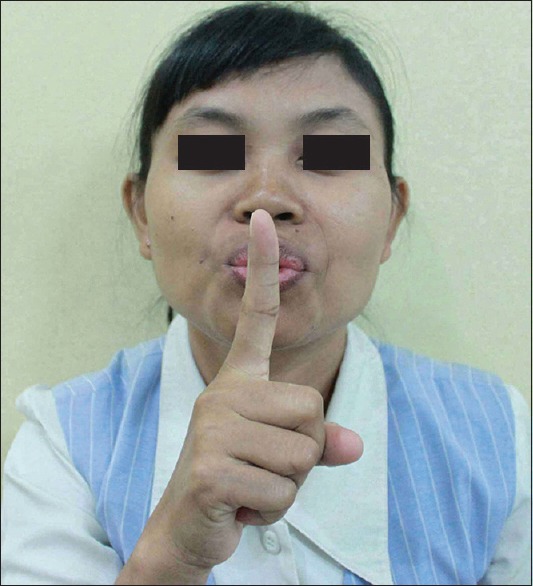
Quiet symbol
Two adult participants commented on picture of dental clinic environment. A picture of the waiting room with an empty sofa and nothing on the wall were felt cold, not friendly, and no differences with any other sitting room environment. They suggested adding other activities like playing on something [Figure 2].
Figure 2.
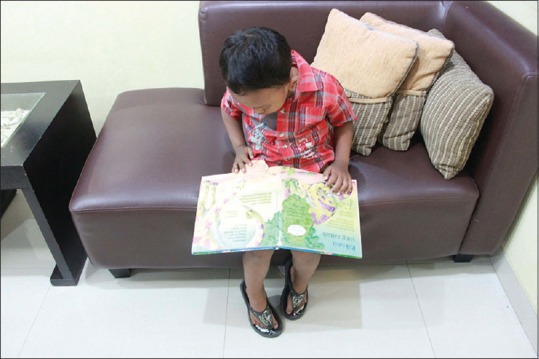
Children in waiting room
Dentist and dental nurse
The majority of the children were able to give description of a dentist but not clearly for dental nurse. They could well distinguish between dentist and dental nurse from the picture [Figure 3]. Another question was regarding mask and gloves that were essential for dentist and dental nurse. Most of them were unable to understand the question but they were able to point mask and gloves in picture [Figure 4]. Two adult participants commented revision to the picture. They suggested two pictures for explaining mask and gloves. The first picture showed a nurse without mask and gloves and second picture showed nurse with mask and gloves.
Figure 3.
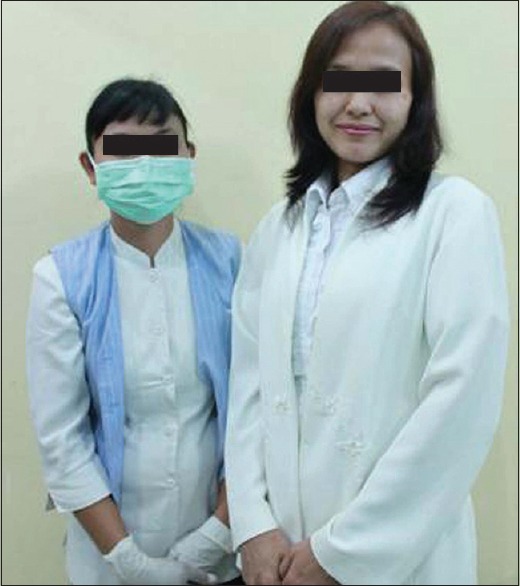
Dentist and dental nurse
Figure 4.
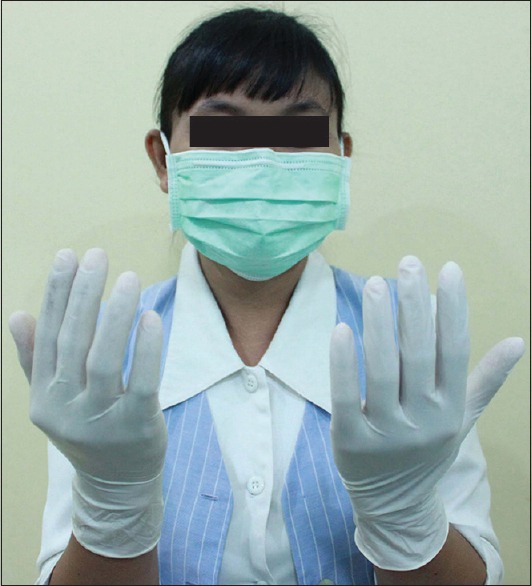
Dental nurse with mask and gloves
Dental chair and treatment position
More than half of the participants were able to answer the question regarding dental chair with some help. The researcher and teacher had to modify the question. The participants said that the dental chair was able to move to “sleep position,” but could not distinguish between the two pictures of upright and reclined seat position [Figures 5 and 6].
Figure 5.
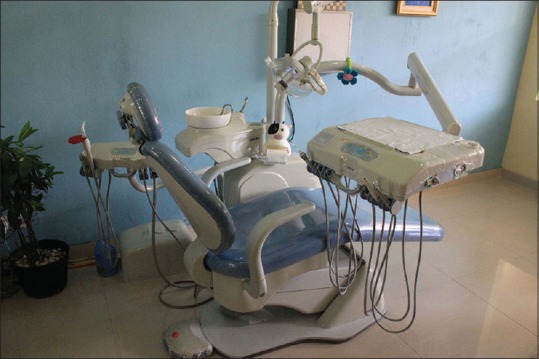
Upright dental seat position
Figure 6.
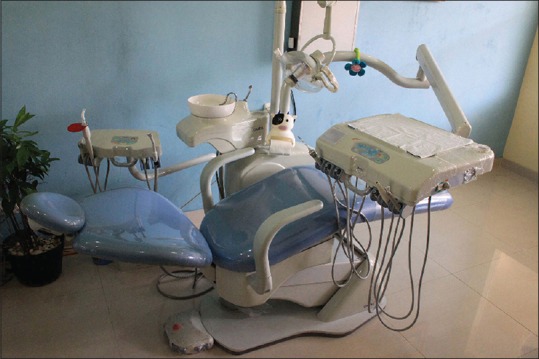
Reclined dental seat position
Adult participants suggested revision for dental chair pictures. Comparison between upright and reclined position should be made more clear. According to them a child sitting in upright or reclined seat were more obvious than empty upright or reclined dental chair.
Dental instruments and dental treatment
Most participating children were not able to describe the dental instruments. Additional pictures, like that of a sprayer or fan, or to explain a three-way syringe also failed to be understood [Figures 7–9]. Dental treatment picture showed a child with an open mouth and a three-way syringe in front of the mouth. No comment was received from the children to this picture. Parents and teachers also had no specific comments [Figure 10].
Figure 7.
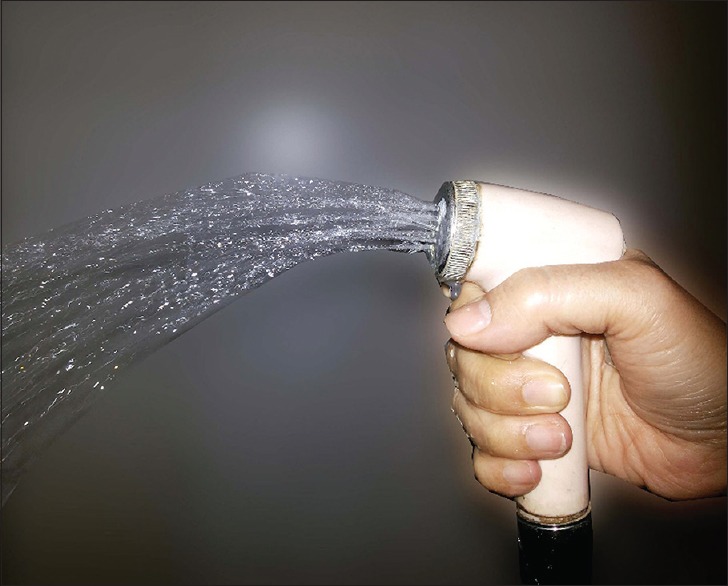
Water sprayer
Figure 9.
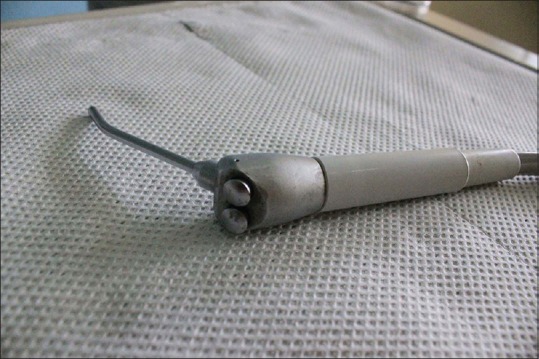
Three way syringe
Figure 10.
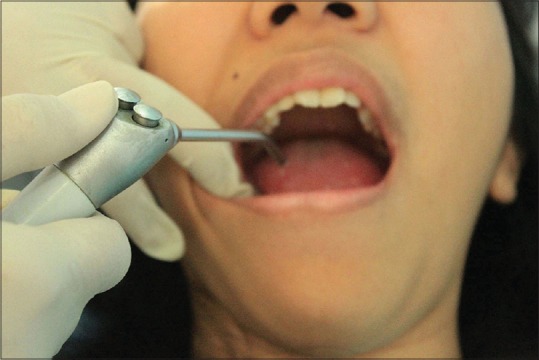
Three way syringe in front of open mouth
Figure 8.
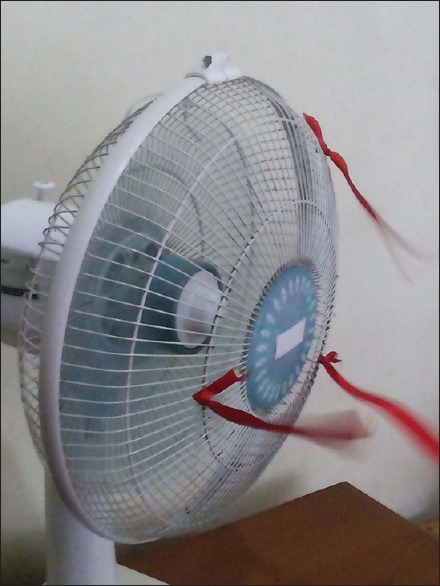
Air fan
Sound of equipment
The question regarding the sound of equipment had to be modified. Researcher and teacher should explain the question with some gestures because not many children could understand the question. However, some could explain that the sound of equipment was hurting the ear. A parent commented that the picture showing a child closing his ears with hands. This photo should be dismissed because it can result in misinterpretation [Figure 11].
Figure 11.
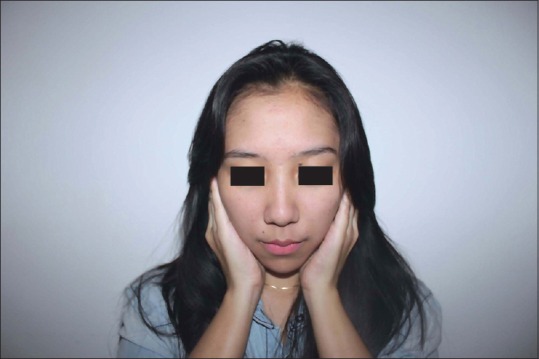
Children close ears with hands
The lamp
All children could explain well about the lamp. They could distinguish off and on light. With some help from the researcher and teacher, half of the children were able to say that the lamp was too bright and eyes should be closed [Figures 12 and 13].
Figure 12.
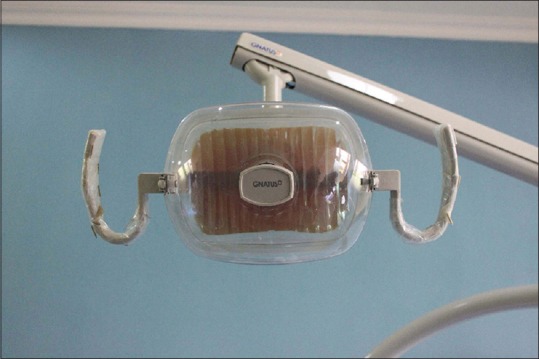
The lamp is off
Figure 13.
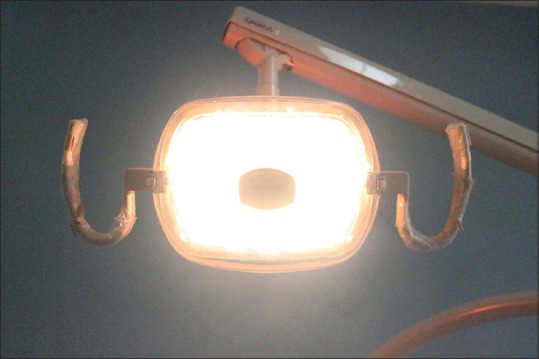
The lamp is on
Rejection
Only 8 of the 10 children followed the interview session to the end. A boy refused to communicate and insisted to get back to his classroom for finishing the subjects that he studied before. Another boy was not willing to sit and just went around the school. Further, another boy could answer the questions but refused to see the picture of a dentist.
DISCUSSION
A functional magnetic resonance imaging study of fusiform face area in the ventral temporal cortex demonstrated that images from topics of interest would elicit more robust response in children with ASD than in typical developing individuals having strong hobby or interest.[18] This was taken to also suggest that brain regions related to social functioning may not be inherently less responsive in ASD but rather recruited by different environmental stimuli. In this study, we addressed the visual perception regarding dental visit activities from children with ASD and their caretakers. Many of the pictures for supporting visual aid were easily recognized by the children, but many also failed to be understood. Caretakers not only gave their perception but also recommendations for revision and improvement.
One of the pictures with no mistakes to understand was the picture of dental nurse with a finger in front of her mouth. All children could explain the meaning and understood the gesture of the quiet symbol. This gesture seems universally familiar for these children. This is in line with the finding that individuals with ASD may understand visual instructions in the form of two-dimensional (written words, line drawing, picture) or three-dimensional (gesture or expression), although may have difficulty in understanding verbal instructions.[11]
A picture that showed a boy reading a book while sitting on a sofa in an empty room was commented by adult participants. The reason of this picture was to minimize distraction because children with ASD have increased difficulty with increasing processing demands.[19] The parents suggested adding furniture and another activity in the picture to make it more easily understandable. Parents opinion may be in line with the finding suggesting that children with ASD are capable of observational learning and can imitate such modelled responses.[20] Picture that is close to a real situation also fulfils their desire of sameness.[7] Almost similar reasoning applies to the picture that showed a boy closing his ears with his hands. Adults suggested to eliminate this picture because children with ASD have capability to imitate. This in line with a study that used a robot to educate children with ASD since they are able to imitate.[21] Two adults also suggested revision to the picture of dental nurse wearing mask and gloves. According to them it would be easier for the children with ASD to understand side-by-side pictures that would show a nurse without mask and gloves compared to a nurse with mask and gloves. Their suggestion may correspond to a study that found the ability of children with ASD in the detection of changes to a visual display.[22] This was proved in this study, especially in the picture of lamp on and off. These side-by-side pictures were very well distinguished by all the children participants. Burack stated that there is no differences in ability on a change detection task from side by side pictures between children with ASD and typically developing children.[22] Interestingly, the side-by-side pictures of upright and reclined dental chair was a little bit hard to recognize by children with ASD. In the picture of the dental chair, problem aroused from almost similar color from the chair upholstery and background wall. A study mentioned that children with ASD were less accurate in color perception.[23] For this picture, parents suggested that there should be a child sitting on the two positions of the dental chair.
The children with ASD are usually extremely sensitive to varying environmental factors and are very dependent on routine and continuity.[4] Thus, an unfamiliar person cannot easily make contact with them. This explained the need of the presence of a teacher during the interview for helping in communication. Children with ASD perform better on tasks that include consistent visual stimuli such as matching, object assembly, pattern analysis, and discrimination.[24] However, their weakness is in abstract thinking, communication, and social cognition.[7] This may explain why they did not understand the meaning of dental instrument working. Cartoon pictures like that of a fan or sprayer failed to be understood, possibly because these pictures needed too much abstract thinking.
One boy was able to answer the questions but rejected to see the picture of dentist. According to him, all doctors cause pain, although he had no experience of sitting in a dental chair. While his answer is logical in the sense that a dentist is also called “doctor” (dokter) in Indonesian, it may also have another reason that children with ASD are strong in associative learning.[8]
The dental visit pictures were also valuable to the parents because the pictures can make it easier for them to bring their children to the dentist. Through visualization, the actual dental procedure could be studied at home before visiting the clinic and to help the child to understand the different parts of the treatment.[4] There is some reason to be cautious about the meaning of parental comments because children with ASD have demonstrated weakness in visual learning.[25,26] Nevertheless, the parents gave many potentially useful suggestions to produce better and more easily understood pictures.
It could be argued that the results are weak in the sense that the responses are given by children with ASD, and therefore with varying cognitive abilities. However, there are no two autistic individuals that are the same, and so they may need different approaches in communication. Therefore the comments on pictures by the child participants and by the adults who take care of them are too precious to be ignored. The fact that the children were helped to answer the question could also be a potential weakness of this study. These pictures nevertheless appear to fulfil their special need for preparing bridges between anything new and the predictable. This study showed that some pictures of dental treatment were easily understood but some needed revision to be comprehensible. The pictures could be better by presenting them with extended means and tools to describe sensory feelings. Comprehensive and integrated treatment approaches might offer the greatest improvements.[25]
In the future research, the effectiveness of these dental visit pictures should be examined in wider age groups of children with ASD in real dental clinic situations. Evidence of the impact of the pictures may then be extended to more complicated dental treatments.
CONCLUSIONS
Many of the pictures on a visit to dental clinic were easily recognized by children with ASD, but some also failed to be understood. Caretakers not only gave their perception but also recommendations for improvement of the pictures. The results suggest that every activity in a dental clinic will be better accepted by the children with ASD if presented in an understandable picture format before having the real experience.
Declaration of patient consent
The authors certify that they have obtained all appropriate patient consent forms. In the form the patient(s) has/have given his/her/their consent for his/her/their images and other clinical information to be reported in the journal. The patients understand that their names and initials will not be published and due efforts will be made to conceal their identity, but anonymity cannot be guaranteed.
Financial support and sponsorship
Nil.
Conflicts of interest
There are no conflicts of interest.
REFERENCES
- 1.DSM.5 Diagnostic Criteria [Internet] New York: Autism Speaks Inc.; ©2016. [Last cited on 2016 May 01]. Available from: https://www.autismspeaks.org/what-autism/diagnosis/dsm-5-diagnostic-criteria . [Google Scholar]
- 2.Barbaro J, Halder S. Early identification of autism spectrum disorder: Current challenges and future global directions. Curr Dev Disord Rep. 2016;3:67–74. [Google Scholar]
- 3.Baio J. Prevalence of autism spectrum disorder among children aged 8 years – autism and developmental disabilities monitoring network, 11 sites, United States, 2010. [Last accessed on 2016 May 11];MMWR. 2014 63:1–14. Available from: http://www.cdc.gov/mmwr/preview/mmwrhtml/ss6302a1.htm . [PubMed] [Google Scholar]
- 4.Pilebro C, Bäckman B. Teaching oral hygiene to children with autism. Int J Paediatr Dent. 2005;15:1–9. doi: 10.1111/j.1365-263X.2005.00589.x. [DOI] [PubMed] [Google Scholar]
- 5.Udhya J, Varadharaja MM, Parthiban J, Srinivasan I. Autism disorder (AD): An updated review for paediatric dentists. J Clin Diagn Res. 2014;8:275–9. doi: 10.7860/JCDR/2014/7938.4080. [DOI] [PMC free article] [PubMed] [Google Scholar]
- 6.Stein LI, Lane CJ, Williams ME, Dawson ME, Polido JC, Cermak SA. Physiological and behavioral stress and anxiety in children with autism spectrum disorders during routine oral care. Biomed Res Int. 2014;2014:694876. doi: 10.1155/2014/694876. [DOI] [PMC free article] [PubMed] [Google Scholar]
- 7.Werf J. The use of visual supports for students with autism in inclusive physical education [Internet] Alabama: Auburn University; 2007. [Last cited on 2011 Jun 08]. Available from: http://etd.auburn.edu/etd/bitstream/handle/10415/913/WERT_JEANINE_47.pdf?sequence=1 . [Google Scholar]
- 8.Quill KA. Visually cued instruction for children with autism and pervasive developmental disorders. Focus Autism Other Dev Disabl. 1995;10:10–20. [Google Scholar]
- 9.Grandin T. Thinking in Pictures: My Life with Autism. New York: Random House; 2006. pp. 37–9. [Google Scholar]
- 10.Mesibov G, Shea V. Full inclusion and students with autism. J Autism Dev Disord. 1996;26:337–46. doi: 10.1007/BF02172478. [DOI] [PubMed] [Google Scholar]
- 11.Tissot C, Evans R. Visual teaching strategies for children with autism. Early Child Dev Care. 2003;173:425–33. [Google Scholar]
- 12.Meadan H. Using visual supports with young children with autism spectrum disorder. Teach Except Child. 2011;43:28–35. [Google Scholar]
- 13.Isong IA, Rao SR, Holifield C, Iannuzzi D, Hanson E, Ware J, et al. Addressing dental fear in children with autism spectrum disorders: A randomized controlled pilot study using electronic screen media. Clin Pediatr. 2014;53:230–7. doi: 10.1177/0009922813517169. [DOI] [PubMed] [Google Scholar]
- 14.Orellana LM, Martínez-Sanchis S, Silvestre FJ. Training adults and children with an autism spectrum disorder to be compliant with a clinical dental assessment using a TEACCH-based approach. J Autism Dev Disord. 2014;44:776–85. doi: 10.1007/s10803-013-1930-8. [DOI] [PubMed] [Google Scholar]
- 15.Thorne S. Interpretive Description: Qualitative Research for Applied Practice (Developing Qualitative Inquiry) 2nd ed. New York: Routledge; 2016. p. 103. [Google Scholar]
- 16.Onwuegbuzie AJ, Leech NL. Sampling designs in qualitative research: Making the sampling process more public. Qual Rep. 2007;12:19–20. [Google Scholar]
- 17.Curry LA, Nembhard IM, Bradley EH. Qualitative and mixed methods provide unique contributions to outcomes research. Circulation. 2009;119:1442–52. doi: 10.1161/CIRCULATIONAHA.107.742775. [DOI] [PubMed] [Google Scholar]
- 18.Foss-Feig JH, McGugin RW, Gauthier I, Mash LE, Ventola P, Cascio CJ. A functional neuroimaging study of fusiform response to restricted interests in children and adolescents with autism spectrum disorder. J Neurodev Disord. 2016;8:15. doi: 10.1186/s11689-016-9149-6. [DOI] [PMC free article] [PubMed] [Google Scholar]
- 19.Minshew N, Goldstein G, Seigel D. Neuropsychologic functioning in autism: Profile of a complex information processing disorder. J Int Neuropsychol Soc. 1997;3:303–16. [PubMed] [Google Scholar]
- 20.Haring T, Kennedy C, Adams M, Pitts-Conway V. Teaching generalization of purchasing skills across community settings to autistic youth using videotape modelling. J Appl Behav Anal. 1987;20:89–96. doi: 10.1901/jaba.1987.20-89. [DOI] [PMC free article] [PubMed] [Google Scholar]
- 21.Huijnen CA, Lexis MA, Jansens R, de Witte LP. Mapping robots to therapy and educational objectives for children with autism spectrum disorder. J Autism Dev Disord. 2016;46:2100–14. doi: 10.1007/s10803-016-2740-6. [DOI] [PMC free article] [PubMed] [Google Scholar]
- 22.Burack JA, Joseph S, Russo N, Shore DI, Porporino M, Enns JT. Change detection in naturalistic pictures among children with autism. J Autism Dev Disord. 2009;39:471–9. doi: 10.1007/s10803-008-0647-6. [DOI] [PubMed] [Google Scholar]
- 23.Franklin A, Sowden P, Burley R, Notman L, Alder E. Color perception in children with autism. J Autism Dev Disord. 2008;38:1837–47. doi: 10.1007/s10803-008-0574-6. [DOI] [PubMed] [Google Scholar]
- 24.Minshew N, Meyer J, Goldstein G. Abstract reasoning in autism: A dissociation between concept formation and concept identification. Neuropsychology. 2002;16:327–34. doi: 10.1037//0894-4105.16.3.327. [DOI] [PubMed] [Google Scholar]
- 25.Eack SM, Bahorik AL, McKnight SAF, Hogarty SS, Greenwald DP, Newhill CE, et al. Commonalities in social and non-social cognitive impairments in adults with autism spectrum disorder and schizophrenia. Schizophr Res. 2013;148:24–8. doi: 10.1016/j.schres.2013.05.013. [DOI] [PMC free article] [PubMed] [Google Scholar]
- 26.Erdödi L, Lajiness-O'Neill R, Schmitt TA. Learning curve analyses in neurodevelopmental disorders: Are children with autism spectrum disorder truly visual learners? J Autism Dev Disord. 2013;43:880–90. doi: 10.1007/s10803-012-1630-9. [DOI] [PubMed] [Google Scholar]


